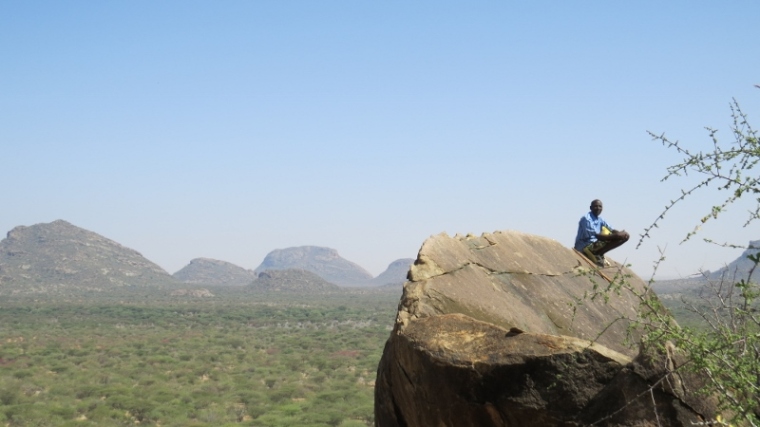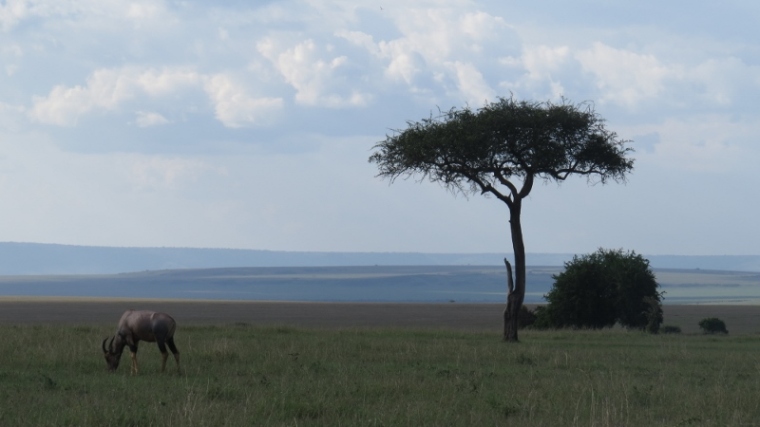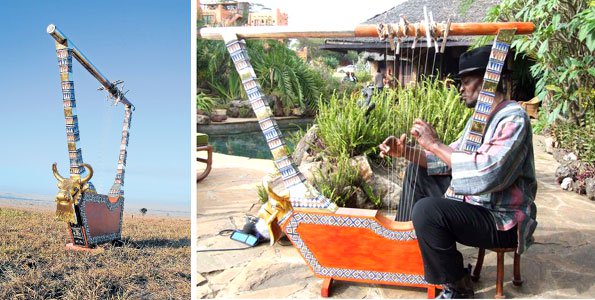Above: Njemps tribesmen light a ceremonial fire in front of a statue of Buddha at Laikipia Nature Conservancy
From the archives 2007 March
Our Earth, the only living planet in the galaxy of millions has never received so much attention as it is now. That it is in dire straits goes without saying. Climate change and global warming are the topics of debate amongst the environmentalists, industrialists, scientists, artists and anyone concerned about our welfare on Earth. It is after all, like l said, the only planet supporting life.

On the edge of the Great Rift Valley, the cradle of human kind, is Ol Ari Nyiro, Laikipia Nature Conservancy, a 100,000-acre of wild country full of gorges and canyons, bush and arid land, water filled dams to support the last of the wild. The Conservancy has been described as ‘the most botaniocally diverse non-forested area in East Africa’ (TP Young 1989). It is home to an indigenous population of black rhinos where Kuki Gallmann established the first rhino sanctuary in Kenya when poachers had almost wiped out more than 95% of the country’s black rhino population by the early 1990s. It is also home to most of the African plethora of wildlife from lions and elephants to the tiny dung beetle and migratory birds like the Ethiopian swallows.
For the last three years, Kuki Gallmann the fiery Italian and Kenyan by choice, has established the Great Rift Valley Academy of Arts to sensitize the public about earth matters through the performing arts. Assisted by her charming daughter Sveva, the Gallmann girls have staged three productions at the edge of the Rift, using the natural backdrop as a vibrant stage for the performances. Prelude the first show was staged in 2005, followed by Wings in 2006 and in February 2007, Earth.
The performing art is a strong medium of expression and imagination, bringing vitality and emotions to sensitive issues.
This year’s Earth had more than 90 artists from as far as Siberia, Russia, North America, the Philippines, India, Greece, Italy, England, Scotland, Germany, South Africa and of course, Kenya.
Kuki is one of a kind. She’s feisty and in her own words, ‘a workaholoic’ and with her shoulder length once blonde now platinum, she jokes she and her colleague Monica Maimone are the ‘two white haired witches working with the magicians.’ Monica is the creative force behind the world renowned outdoor production company, Studio Fresti. She has put on shows in spectacular world settings like the Grand canyon in the United States of America, the Pope’s millennium celebrations in Rome and the recent opening of the winter Olympics in Turin, where our own Nobel Laureate Professor Wangai Maathai was one of the leading personalites in the opening of the games.

All three productions have been different which is a bench-mark for attracting the same patrons and attracting new one.
In Earth, Kuki changes the venue and creates a new theatre on the Conservancy, called Woodhenge. As a deeply spiritual person much of what she does or creates has to do with her strong sense of emotion. She chose this venue when one evening she found herself on the large sloping glade called Mbogani ya Ndume facing the Mukutan Gorge, distant hills and a lake. In the silence of the place, she felt the spirit of the ancient land and decided to build an amphitheatre to celebrate special gatherings, prayers and performances by artists from the world across. It was the beginning of Woodhenge.
“It was Kuki’s idea to build the theatre,” says Slobodan Randjelovic, the designer-architect responsible for creating the stage for Prelude and Wings, and now Woodhenge.
“She didn’t want just an ordinary theatre but somewhere where people can get together for meetings and ceremonies.
“We didn’t want anything geometrical save for the circle because there is nothing in nature with a 90 degree angle. We agreed upon the Fibonacci Code. The Fibonacci Code known as the ‘golden proportion’ is the universal index that dictates the spatial relationship between any two elements in nature, striving for beauty and completeness in the realms of both nature and art. It reflects and is often found in nature like in the arrangement of sunflower seeds, in shells like the nautilus and in the branching of trees.”

The Fibonacci Code can be configured in a series of numbers, where the summary is the sum of the previous two numbers (1+2=3; 2+3=5; 3+5=8 and so on). The orientation of the amphitheatre is complemented with the proinciples of Feng Shui, the ancient Chinese code of using the earth’s compass to bring in good energy. The six converging rows of seats face the stage surrounded by the gigantic trunks of dead African olive trees, the Mutamaiyu, placed to look like natural pillars to guard and protect the place.
As with all ceremonies in the Conservancy, Earth begins with the blessings of the elders of the Turkana, Samburu and Pokot dressed in traditional finery of hides and beads. In the glow of the ethereal orange-gold light of the setting sun, the quartet of Huun Huur Tu, the Tuvans, begin their recital with flutes and deep throated singing in which a single vocalist simultanousely prodces two sounds – a high note and a melodious one.
For the next 2 hours, the spectators are taken on a visual arts spectrum of a fusion – Indian classical dance performed by Preetika Hirani to Pantelis Pavlidis’ Mediterranean instruments like the lyre and the flute. The Greek man with a mop of wavy hair is acknowledged as one of the most significant artistic creators and renovators of contemporary folk music art. The duo’s performance is one of cultures blending which at first in the words of the young dancer and the in-house ecologist at the Conservancy “didn’t seem possible but Pantelis explained his music and together we worked on the moves.”

Ayub Ogada based in the west is Kenya’s own son from Luo land. He has taken the African traditional music instruments like the Nyatiti to the international stage, which he wows the audience to. “I want my music to reach everyone. I want to play for my people,” says the muscician philosophically, hoping to have more exposes in venues across the country.
“The African sound is completely different from the European classical sound,” says Monica Maimone, “The European instruments like the cello, flute and saxophone can give the African sound a melody that it does not have,” says the Italian woman in halting English, breaking into French and Italian. “Au contraire, the African sound can go with classical sound that the classical sound does not know. It’s interesting for the artists and dancers to work with this medium.
She talks further about the fusion of dances – the African and the western. “The African dancers use their whole body, especially the hips. In western dance like ballet, it’s mostly the use of legs and arms but not the hips.”
Having worked on three productions at the Conservancy, Monica also has her own philosophy about the state of the Earth.
“In shows like these, there is a story. There is a need to talk about issues. We are only borrowing this earth because we are here for now and so we have to take care of it to pass it on to the next generation. But l also believe that the Earth is stronger. The human race will destroy itself but the Earth will live.”
In the midst of a country surrounded by farmlands and parceled into small, fenced plots, the former cattle ranch appears from the air as a lush, green carpet of shrub and forest. It was a conscious decision by Kuki to convert the land back to its natural state for reasons that reflect her concern for the Earth.
“Land belongs to everyone. We established the Gallmann Memorial Trust to protect the land to perpetuity. When l came here (in the 1970s) there was forest around us. Today, there is no forest left on our neighbouring land. I have pledged to plant 1 million trees this year to reafforest the land. I have planted 1000 trees so far and have 90,000 to go.”
The African olive has a life span of over three hundred years. But most importantly, indigenous trees and shrubs like the leleshwa offer eco-services such as holding the soils together, contributing to rainfall, surviving bush fires and enriching the earth with nutrients even when dead.
It becomes an elaborate ceremony. One thousand holes for the trees are measured by Slobodan Randjelovic in relation too the Finonacci Code. The site of the ceremony is lined with branches of the Euclea divinorum which is used by the three communities – the Samburu, Turkana and Pokot – as a symbol of peace, regeneration and calmness. A fire is lit in the center of the Fibonacci spiral. The three elder women from the three communities – Cheptossait Selale representing the Pokot, Mama Selale representing the Turkana and Nanyeke Lodungokiok representing the Samburu bless the ceremony after the youngsters from Mtaro Primary school present their skits on the past, present and future earth.
Africa is sandwiched between the two great deserts of the world, the Sahara in the north and the Kalahari in the south. Kenya has its own Chalbi in the north. Once the soils turn into bare particles of sand, only the mirages will shine on the glimmering sand, fooling the eye into believing that it’s water where there is none. It will be all gone, thanks to global warming.
It’s our responsibility to leave virgin forests standing and planting trees for life.


What a beautiful ceremony and such an important message.. There are too many people, and too many important world leaders, who just don’t take global warming as seriously as they should.
LikeLike